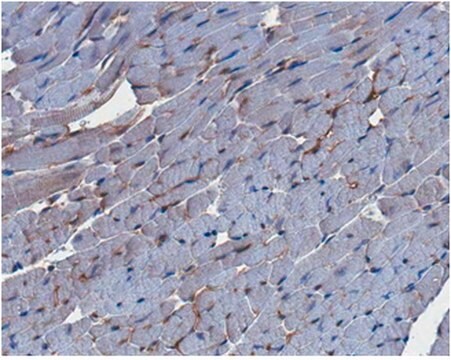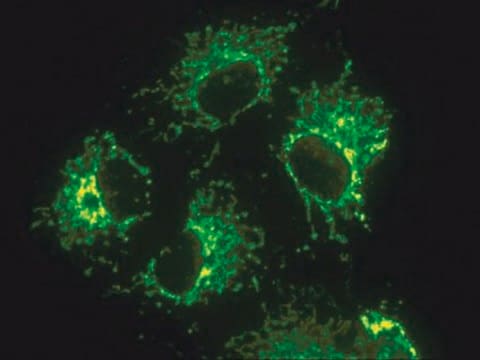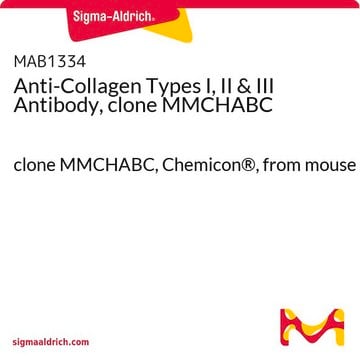MABS1273
Anti-Thrombomodulin Antibody, clone 411-201B
clone 411-201B, from rat
Synonyme(s) :
Thrombomodulin, CD141, Fetomodulin, SnoRNA MBII-339, TM
About This Item
Produits recommandés
Source biologique
rat
Niveau de qualité
Forme d'anticorps
purified immunoglobulin
Type de produit anticorps
primary antibodies
Clone
411-201B, monoclonal
Espèces réactives
human, mouse
Technique(s)
ELISA: suitable
electron microscopy: suitable
immunohistochemistry: suitable (paraffin)
immunoprecipitation (IP): suitable
western blot: suitable
Isotype
IgG2aκ
Numéro d'accès NCBI
Numéro d'accès UniProt
Conditions d'expédition
wet ice
Modification post-traductionnelle de la cible
unmodified
Informations sur le gène
human ... THBD(7056)
Description générale
Immunogène
Application
Electron Microscopy: A representative lot detected thrombomodulin immunoreactivity associated with capillary endothelial cells by EM using frozen mouse lung sections (Kennel, S.J., et al. (1988). Lab. Invest. 59(5):692-701).
Immunoprecipitation Analysis: A representative lot immunoprecipitated the 112 kDa thrombomodulin from normal mouse lung fibroblast (NMLF) lysates, but not from thrombomodulin-depleted NMLF lysates by performing IP with clone 273-34A (Cat. No. MABS1245) prior to IP with clone 411-201B (Kennel, S.J., et al. (1988). Lab. Invest. 59(5):692-701).
Western Blotting Analysis: A representative lot detected thrombomodulin (P112) in the normal mouse lung fibroblast (NMLF) immunoprecipitates obtained with either clone 411-201B or clone 273-34A (Cat. No. MABS1245) (Kennel, S.J., et al. (1988). Lab. Invest. 59(5):692-701).
Immunohistochemistry Analysis: Representative lots and clone 273-34A (Cat. No. MABS1245) showed similar staining pattern using both frozen and paraffin-embedded mouse lung sections (Ford, V.A., et al. (1992). J. Biol. Chem. 267(8):5446-5450; Rorvik, M.C., et al. (1988). J. Histochem. Cytochem. 36(7):741-749; Kennel, S.J., et al. (1988). Lab. Invest. 59(5):692-701).
ELISA Analysis: Representative lots were used as the detection antibody for the detection of thrombomodulin in mouse tissue samples by sandwich ELISA using clone 273-34A (Cat. No. MABS1245) as the capture antibody and an HRP-conjugated secondary antibody, or by sandwich radio-immunoassay employing 125I-labeled clone 411-201B without an enzyme-conjugated secondary antibody (Isermann, B., et al. (2001). Development. 128(6):827-838; Conway, E.M., et al. (1999). Blood. 93(10):3442-3450; Weiler-Guettler, H., et al. (1996). Circ. Res. 78(2):180-187; Ford, V.A., et al. (1992). J. Biol. Chem. 267(8):5446-5450).
Signaling
Immunoglobulins & Immunology
Qualité
Immunohistochemistry Analysis: A 1:1,000 dilution of this antibody detected Thrombomodulin in mouse lung tissue.
Description de la cible
Forme physique
Stockage et stabilité
Autres remarques
Clause de non-responsabilité
Not finding the right product?
Try our Outil de sélection de produits.
Code de la classe de stockage
12 - Non Combustible Liquids
Classe de danger pour l'eau (WGK)
WGK 1
Point d'éclair (°F)
Not applicable
Point d'éclair (°C)
Not applicable
Certificats d'analyse (COA)
Recherchez un Certificats d'analyse (COA) en saisissant le numéro de lot du produit. Les numéros de lot figurent sur l'étiquette du produit après les mots "Lot" ou "Batch".
Déjà en possession de ce produit ?
Retrouvez la documentation relative aux produits que vous avez récemment achetés dans la Bibliothèque de documents.
Notre équipe de scientifiques dispose d'une expérience dans tous les secteurs de la recherche, notamment en sciences de la vie, science des matériaux, synthèse chimique, chromatographie, analyse et dans de nombreux autres domaines..
Contacter notre Service technique







